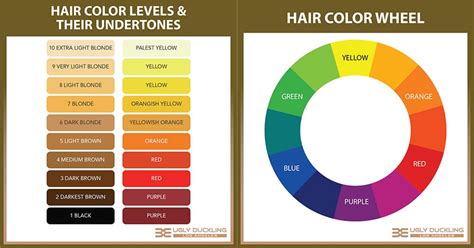The hair color wheel is a visual representation of the relationship between different hair colors. It can be used to help you choose the perfect shade for your skin tone, eye color, and personal style.

How to Use the Hair Color Wheel
The hair color wheel is divided into three primary colors: red, yellow, and blue. These colors are arranged in a circle, with their complementary colors (the colors directly opposite them on the wheel) located on opposite sides of the circle.
To use the hair color wheel, simply find your desired color on the wheel and then look at the complementary color. This will give you an idea of what shades will look best with your chosen color.
For example, if you want to dye your hair red, you would look at the complementary color, green. This means that shades of green would look great with red hair.
Choosing the Right Hair Color for Your Skin Tone
Your skin tone is one of the most important factors to consider when choosing a hair color. If you have fair skin, you should stick to lighter shades of hair color, such as blonde, light brown, or auburn. If you have medium skin, you can wear a wider range of hair colors, including both light and dark shades. If you have dark skin, you can wear darker shades of hair color, such as black, brown, or burgundy.
Choosing the Right Hair Color for Your Eye Color
Your eye color is another important factor to consider when choosing a hair color. If you have blue eyes, you should stick to cooler shades of hair color, such as blonde, light brown, or auburn. If you have brown eyes, you can wear a wider range of hair colors, including both cool and warm shades. If you have green eyes, you can wear warmer shades of hair color, such as red, orange, or yellow.
Choosing the Right Hair Color for Your Personal Style
Your personal style is also an important factor to consider when choosing a hair color. If you have a classic style, you should stick to more traditional hair colors, such as blonde, brown, or black. If you have a more modern style, you can experiment with more unconventional hair colors, such as pink, blue, or green.
Common Mistakes to Avoid
There are a few common mistakes that people make when choosing a hair color. These include:
- Choosing a hair color that is too dark for your skin tone. This can make you look washed out and tired.
- Choosing a hair color that is too light for your skin tone. This can make you look like you have a fake tan.
- Choosing a hair color that does not complement your eye color. This can make your eyes look dull and lifeless.
- Choosing a hair color that does not match your personal style. This can make you feel like you are not being true to yourself.
Pros and Cons of Different Hair Colors
Each hair color has its own unique set of pros and cons. These include:
Blonde
- Pros: Blonde hair is universally flattering and can make you look younger. It is also easy to maintain.
- Cons: Blonde hair can be difficult to achieve on dark hair and can require a lot of upkeep.
Brown
- Pros: Brown hair is a natural color that is easy to maintain. It is also versatile and can be styled in a variety of ways.
- Cons: Brown hair can be boring if it is not styled properly.
Black
- Pros: Black hair is a striking and sophisticated color. It is also easy to maintain.
- Cons: Black hair can be harsh on the skin and can make you look older.
Red
- Pros: Red hair is a fiery and passionate color. It is also very unique and can make you stand out from the crowd.
- Cons: Red hair can be difficult to achieve and maintain. It can also fade quickly.
Other colors
- Pros: Other colors, such as pink, blue, and green, can be a lot of fun to experiment with. They can also help you express your creativity.
- Cons: Other colors can be difficult to achieve and maintain. They can also fade quickly and can be damaging to your hair.
FAQs
Here are some of the most frequently asked questions about hair color:
Q: What is the best hair color for me?
A: The best hair color for you depends on your skin tone, eye color, and personal style.
Q: How often should I dye my hair?
A: The frequency with which you dye your hair depends on the type of hair color you choose. Some hair colors, such as blonde, require more frequent touch-ups than others, such as brown.
Q: Can I dye my hair at home?
A: Yes, it is possible to dye your hair at home. However, it is important to follow the instructions carefully and to use a high-quality hair dye.
Q: What are the risks of dyeing my hair?
A: Dyeing your hair can damage your hair if it is not done properly. It can also cause allergic reactions in some people.
Q: How can I prevent my hair color from fading?
A: You can prevent your hair color from fading by using a color-protecting shampoo and conditioner. You should also avoid using hot water on your hair and protect it from the sun.
